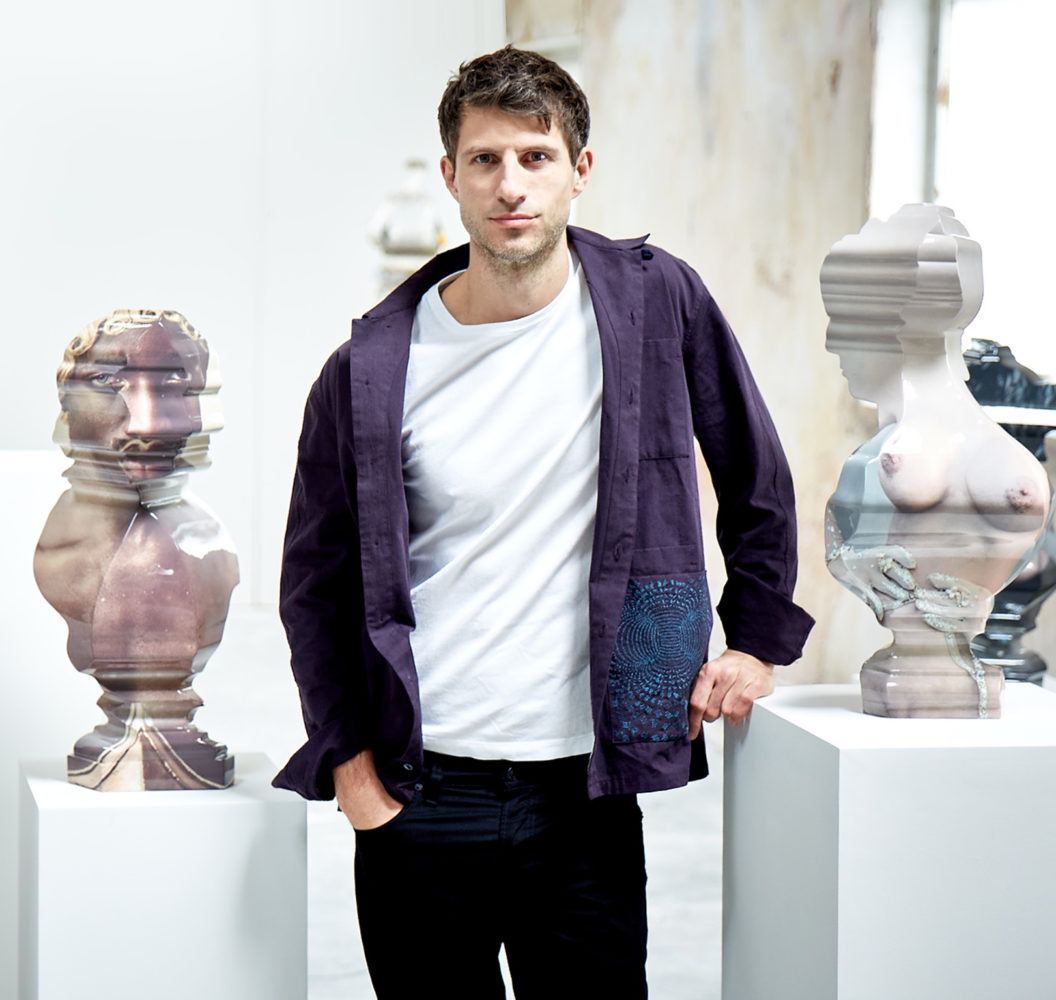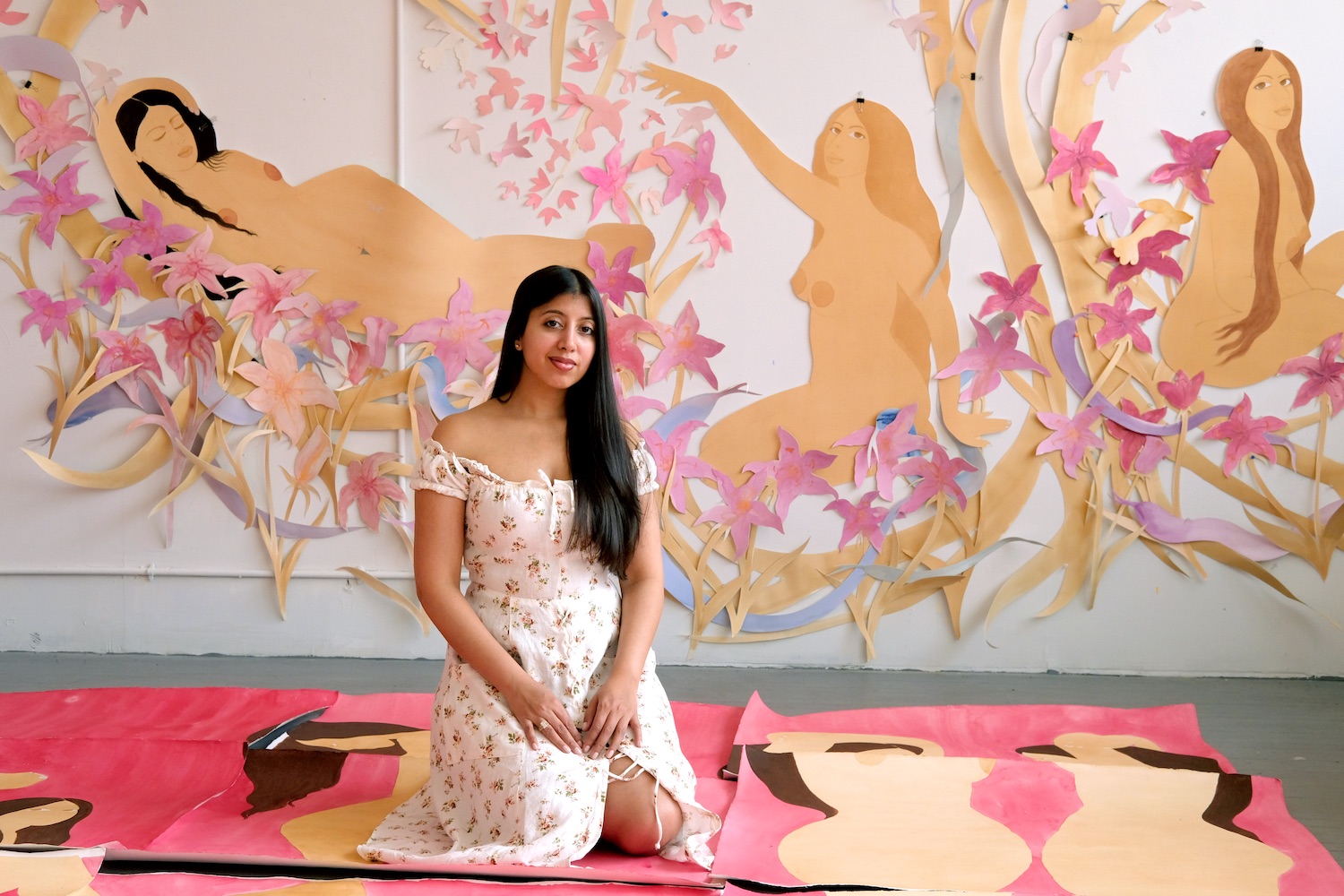Nick Hornby’s “Zygotes and Confessions” is currently on view at Wales’s contemporary art space MOSTYN through April 21. Curated by the gallery’s Director Alfredo Cramerotti, the exhibition features a series of photo-sculptural works exploring gender and sexual identity, through the lens of our relationship with the world of screens.
Existing on the brink of the two- and three-dimensional planes, the works on view were made by a unique hybrid of digital and manual processes, where sculptural forms are submerged in liquid crystal displays to cover them in photographic images. Coined by the artist as “meta-cubism,” the entrancing pieces present themselves as abstracted suggestions of classical sculpture where the viewer might take a second (or even third) look before adjusting to the chameleonic nature of the figures. Nine works were created in collaboration with the photographer Louie Banks, whose images feature drag queens and transgender models.
Taking into consideration a zygote, which does not yet possess a sexual identity, Hornby has delved into a level of personal intimacy new to his work by linking suggestions of autobiography back to our ample use of screens. Through the presentation, the artist underscores how fickle boundaries between personal and formal can be today, offering a physical representation of the intangible world that exists beneath our fingertips.
To learn more about Hornby’s show and his practice as a whole, Whitewall is sharing a discussion between the artist and the curator.
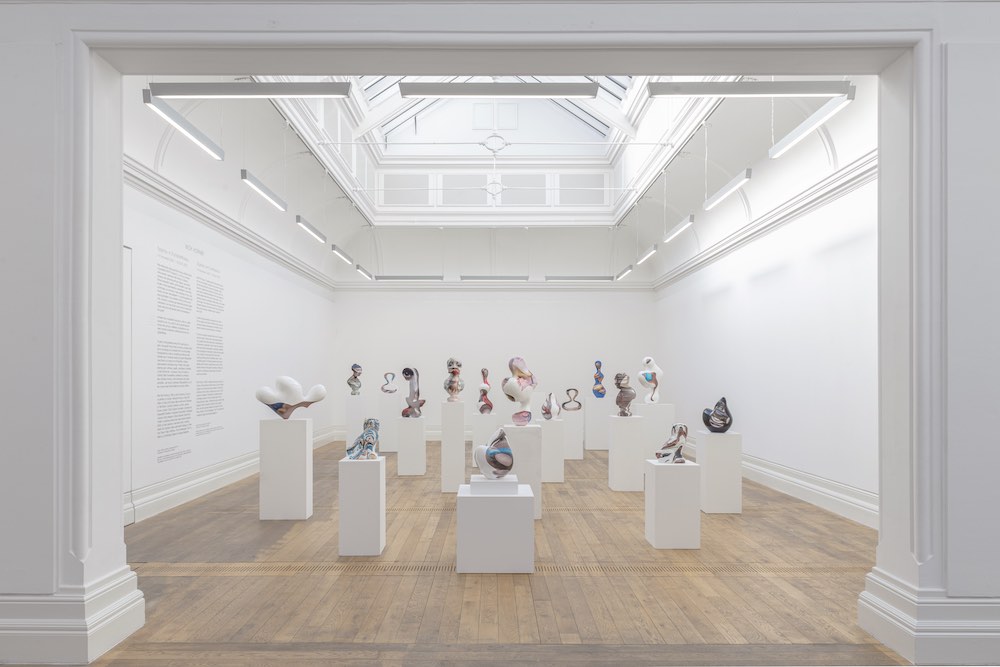
Installation view of Nick Hornby’s “Zygotes and Confessions,” courtesy of the artist and MOSTYN.
ALFREDO CRAMEROTTI: Let’s start with the main ideas behind your work—I realize this is a big question, and of course I have my own reading, but it may not be the same as yours. How do you ‘read’ your work? Can you step outside Nick Hornby for a moment and let me know what you see?
NICK HORNBY: A painter is often said to step back from a canvas to see it more clearly. I like imagining that back and forth: from the brush hairs touching the bumpy surface of a canvas to the view of the whole painting, in a room, in a house, in a universe. It seems counterintuitive to step away to perceive more clearly, but I think it works. And that’s probably why shifting perspective has been at the centre of my practice for such a long time.
I’m conflicted about the idea of intention. I think being very self-conscious can complicate intention, and that it’s a slightly prescriptive notion anyway: I want my sculptures to be open, multivalent objects rather than articulations of a particular idea or intention. To put it another way: in art there are narratives around taking a critical position, having critical distance, setting everything in a matrix of judgement and value. My intersection sculptures (robotically cut, art-historical hybrids ) in some ways speak to those anxieties—they remove my subjectivity from the mode of production—by using citations, calculating the design by a Boolean operation, and then cutting out the results using digital fabrication. From nose to tail, when these began I was trying to eliminate myself, trying to stand outside the work (as you describe) and see it as If I were a critic rather than a maker. For all the distancing, though, I still choose the quotes, the process, and select the successes. Those decisions reflect taste, and I don’t know where that comes from: could a balance of curves and angles I like be defined by my mother’s face, or my grandmother or her ancestor, for instance? If I ‘read’ my work, I see all these questions in it too. The recent sculptures are much more clearly intimate and personal, complicating those ideas even more. Some of the new works have titles like Harry, Giovanni, Francesco, Joe…. when I see those works I see those people.
AC: Did you get any particular source of inspiration for the visual styles of your recent series of works—for instance, the details of bodies, the art history-inspired shapes, the smooth surfaces, etc.—or did they arrive in relation to the nature of the materials you have used, and relations (either physical, psychological or situational) you were positioned in?
NH: I was looking a lot at Hans Arp. Arp slipped between writing poetry and making visual art—and I found his working between them fascinating. He was also bilingual and even had two names, Hans and Jean. These dualisms obviously appealed to my interest in hybridity. I always look at Tony Oursler. Beyond those two, I was inspired by iPhones, online dating, and the discovery of a slick industrial finish.
The photographs of bodies are mostly cropped, extreme close-ups. They are intended to be part coquettish, part fetishisitic. After working a lot with monochrome outlines introducing photography felt like bringing a nuclear bomb to a knife fight: photographs drip with meaning. Making them glossy nods to the iPhone and the hermetic seal. I tend to triangulate—here there is the shape, the image and the new process of joining them. So the recent series is a compound gesture, with a new autobiographical subject and a new process both interrupting my Boolean-based approach.
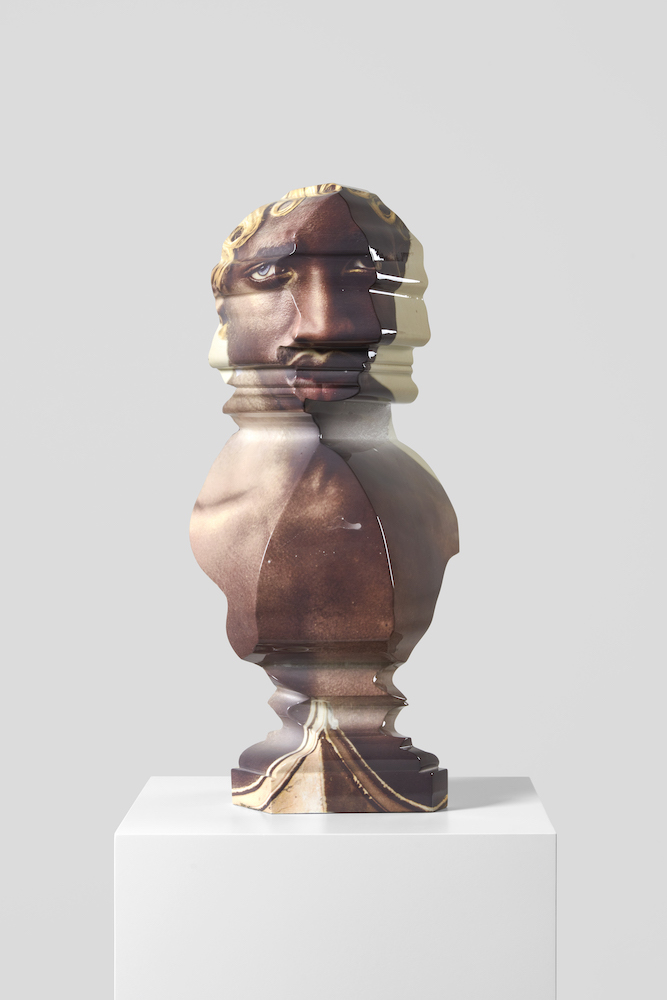
Nick Hornby, “Prof II (Lucky),” 2020, Marble resin composite, ink, lacquer, 60 x 28 x 28 cm, made in collaboration with Louie Banks, courtesy of the artists and MOSTYN.
AC: Can you dive a bit into the technical aspects of the works? Such as the gathering of raw material, software or hardware (in the wide sense; they could be thoughts and materials) used, as well as the selection and editing process? What are some of the particular challenges you (and your team, or the collaborators you work with) have faced in realizing the works?
NH: For me the strength of this body of work is the uncanny strangeness of these things—how they appear simultaneously art-historical, industrial, and technological—so I’m a bit reluctant to talk about process in case it diminishes that strangeness. The objects pass through many steps: digital, analogue, robotic cutting, traditional casting, and carefully hand applied images, and a lot of ideas get resolved in each of those stages.
AC: I’ve seen several installations of your work–here at MOSTYN obviously, but also in commercial galleries as well as Glyndebourne Opera House gardens. I always had the feeling I was ‘entering’ something, although just subtly and not physically. As a viewer, whilst I was able to move from and to, around the works—or beside them, or between them—I could not really experience them from an ‘external’ point of view. The display of your current exhibition at MOSTYN reiterates this feeling – it seems to me that your work in general is not meant to be ‘faced’ so to speak, and not only because it’s sculpture. There’s something else going on about how you want to present your work. You chose to have an ‘immersive’ type of experience. What is the underlying approach to this?
NH: I feel that exactly. My sculptures are designed to encourage audiences to circumnavigate them, so that they can see an object anew, or see that from one aspect the sculpture is entirely different from what they first expected. With the intersection pieces—I wonder if there isn’t a quality of their visual language that makes it clear that each object is the result of a compound operation: you see the result but not the process. It’s apparent there is a process but not what it is. I definitely want to posit the notion that there is a path that could be found. But I don’t want the work to be inaccessible in the ways that might sound either. Quite the reverse—I want the sculptures to intrigue on a formal level and invite inquiry.
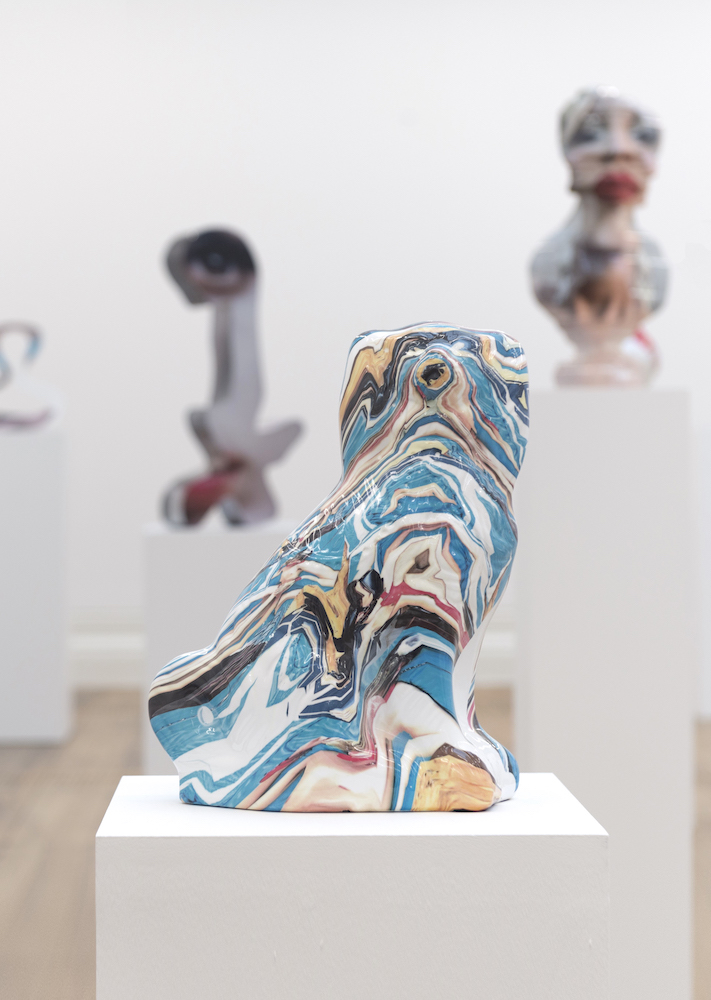
Nick Hornby, “Dear Dashy Dash,” 2020, Resin, ink, lacquer, 36 x 28 x 15 cm; courtesy of the artist and MOSTYN.
AC: Tell me a secret about your work. Even a small one.
NH: I don’t have secrets anymore. My production is quite secretive to the extent that the finish obscures the making: the sculptures’ surfaces are seamless. In Mythologies, Roland Barthes sets the abstract – the “superlative object” with its “perfection and absence of origin” making it look like something “fallen from the sky” against “the technical and typically human operation of assembling.” So if the painter steps away from the canvas to see the work, my secrets are all in the sculptures’ reflective surfaces: whilst there are clues—there’s nothing as clear as a brush stroke to betray how they got there.
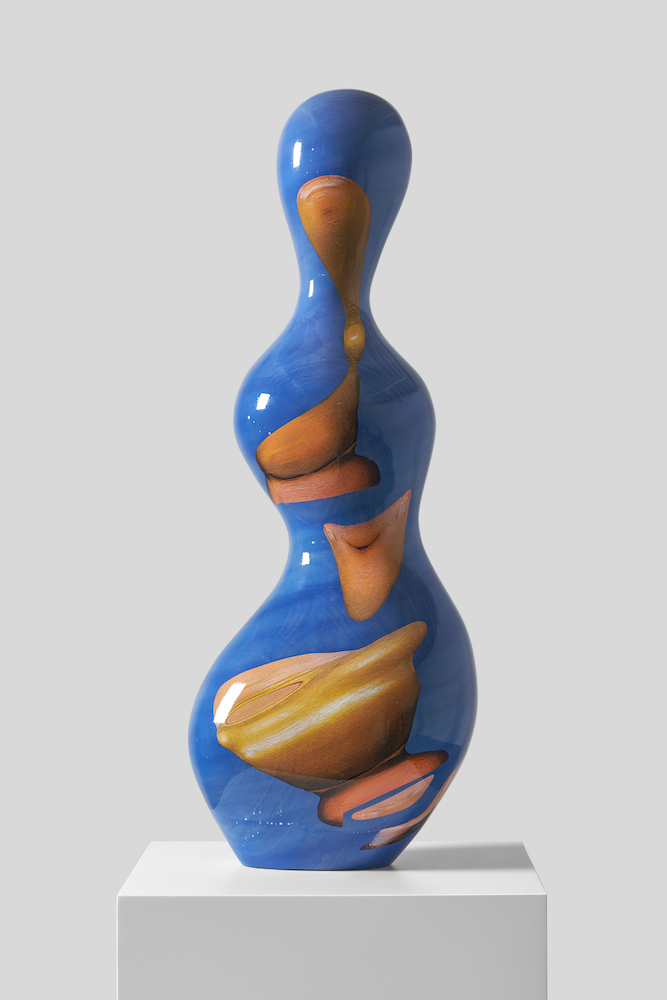
Nick Hornby, “Torso Fruit (Cindy) or Demeter’s Doll (Cindy),” 2020, Resin, ink, lacquer, 80 x 29 x 20 cm; courtesy of the artist and MOSTYN.



